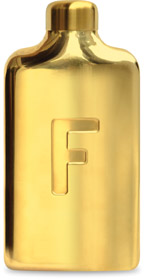 Just one sip is all it takes.
Just one sip is all it takes.
As Americans, our primary job these days is to consume. In the past, we were the place where folks used to drop off their huddled masses yearning to breathe free. At one time, we were also a mighty Olympic power as well as the primary exporter of democracy around the globe.
But now, we mainly buy stuff. This is where Fred Beverage Company comes in.
Like anyone selling bottled wet stuff, the Sausalito company faces a significant hurdle: How do the guys at Fred convince you to buy something you can obtain simply by getting out of your comfy chair, walking into your ultra-modern kitchen, turning on the tap and capturing what comes forth in a glass?
Now before you go to your computer to send a ferocious email about how the health dangers of the world travel that dark highway from the reservoir or aquifer to your kitchen faucet—and how nobody born after 1990 would consider polluting the holy temple that is their body with something as imperfect as tap water, let’s do some math.
The National Resources Defense Council said last year the average cost of tap water in California is $1.60 for 1,000 gallons, or roughly one-tenth of one cent per gallon. The Beverage Marketing Corporation reports the average wholesale cost of a gallon of bottled water is $1.21.
Wholesale, not retail.
So let’s agree that, from a purely economic standpoint, bottled water is a fiery train wreck as a consumer choice. And to revisit the point made earlier, we consume like madmen.
So how does Fred sell its water? The private company that got its start in Brooklyn in 2007 has found a very creative way of selling its branded H2O by not exactly selling the water at all.
Most water companies rely on a number of proven sales hooks to get America to buy their product. Some of them give you the subtle side, selling the fear that tap water is the devil’s playground when it comes to germs, disease and all things that make you a loser; so bottled water is the healthy choice because it comes from a pristine environment. Poland Spring Water, made by multinational food conglomerate Nestle S.A. is a prime example of this school of sales. One of its commercials gives you a simulated ride down a waterfall, and tells you that only 1 billionth of 1 percent of the “earth’s 358 million billion gallons of water” is filtered naturally beneath the earth, and then hits you with the tag line: “Born Better.”
Fred doesn’t do it that way.
Another sales hook is the idea that bottled water tastes like a spring day in which every shelter puppy was adopted, peace broke out in the Middle East and global warming was cured. That water would taste awesome, but Fred doesn’t embrace this route, either.
Some water brands sell you water by linking it to a better social status. It used to be that a simple green bottle of Perrier communicated to the outside world that the person sucking on that bottle was seeking a better image and, in some circles, it worked. Today, this shtick is mostly isolated to restaurants where the server asks if you would like to start off with some water, either still or carbonated.
I don’t blame the restaurant for looking to build its tab and, as we already covered, retail water comes with a terrific margin. And the diner not only receives something to wet his or her whistle but also a bottle sitting on the table that says he or she has better taste than the rest of the patrons who are chugging tap water swill.
But Fred doesn’t really lean on this sales tactic, either.
One very popular route is to have a celebrity endorse your water. Smartwater, a privately owned division of Coca Cola, hired actress Jennifer Aniston to hype its product, which included an almost three-minute YouTube video making fun of selling on the Internet. It got more than 2 million views—though that might have something to do with the title, “Jennifer Aniston Sex Tape.” New England Patriot’s quarterback Tom Brady also sells Smartwater.
Vapor-distilled Smartwater, with its added electrolytes, has plenty of company when it comes to famous people pulling down cash selling water. Pop singer Ariana Grande is pushing Wat-ahh; Mark Wahlberg and P. Diddy front AQUAhydrate; Beyoncé shilled for Crystal Geyser; actress Ashley Greene of “Twilight” fame hypes SoBe Lifewater; while Vitamin Water had rapper 50 Cent, singer Carrie Underwood and comedian Ellen DeGeneres, each with their own flavor.
Now we’re moving into Fred’s wheelhouse a little. Skateboard superstar Tony Hawk appears in a video for Fred. Granted, Hawk doesn’t have the same Q rating as Aniston or Wahlberg, but in the boardsport world, he’s like the Pope, only without the elaborate hat and the bullet-proof Popemobile.
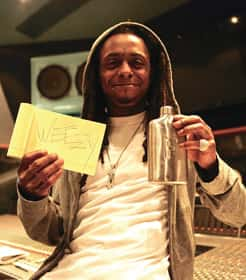 Hawk isn’t the only celebrity showing Fred some love. Rapper Lil Wayne also appears in the video and, in a press release from the company, Weezy declares that, “Fred Water is dope, plain and simple.”
Hawk isn’t the only celebrity showing Fred some love. Rapper Lil Wayne also appears in the video and, in a press release from the company, Weezy declares that, “Fred Water is dope, plain and simple.”You can’t make this sort of thing up. Well, in this case, you probably could, but the company says Lil Wayne’s allegiance to Fred is real, and it has the photos to prove it. As a matter of fact, Lil Wayne had a direct impact on this story.
For the better part of two months, Fred and this periodical tried valiantly to line up an interview, but as the days grew shorter and winter set in, Lil Wayne got involved. The company’s PR pro Kirsten Woodard sent this email: “Sorry for the delay—they [Fred] had an announcement today that Lil Wayne is now loving the product too, so [CEO] Adam has been very hard to get ahold of.”
Clearly, it was a fluid situation. Sorry, couldn’t help myself. In the end, NorthBay biz and Fred were unsuccessful in connecting for a chat.
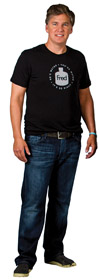 This is how Fred sells its water
This is how Fred sells its water
So Fred peddles its product via connecting it to celebrities. But that isn’t its main technique. The biggest tool in the Fred sales arsenal is its bottle. It’s shaped like a flask, though the company says it’s styled after a “frontier-style bottle.” It’s also a very close cousin of, say, a pint of Jameson Irish whiskey, and Fred says it’s more transportable than traditional water bottles, because it fits into your back pocket (assuming you’re wearing pants, and that those trousers have pockets).
The bottle is BPA- and phtalate-free, and part of the company’s hook is that consumers should refill the bottles with tap water. “There’s this weird thing about water, where if you don’t drink it, you die,” according to the Book of Fred on the company website. “A bottle that is not only easy to carry around, but lends itself to being refilled again and again and again. Most water companies will not recommend this behavior. Because they think it is bad for business. But we are OK with taking a little hit. The water you refill your bottle with may not be as smooth as Fred, but it’s still water. And in addition to keeping bottles out of the landfill and saving yourself a few bucks, you will also be doing a bang-up job of not dying.”
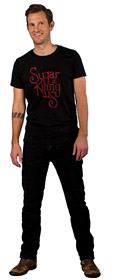
Fred may not be taking that big a hit on the tap water part, since the company sells its bottles empty as well. You can buy two 13.5-ounce empty bottles for $7 or two 20-ounce bottles for $9. There may be other water companies in the United States selling their water without any water, we just didn’t find them.
The company, which is led by President/CEO Adam Gayner, Creative Chief Ariel Broggi and CFO Heather Lourie, has concentrated its efforts at marketing in the digital and social environs and signed up with ad agency Made Movement. Based on the images from the company’s website as well as a video it produced, Fred isn’t aimed at every thirsty American, but rather the younger and more active demographic. The company has also aligned itself with the skateboarding world event sponsorships.
Last October, the company added Stephen Gordon to its board of directors. Gordon is no stranger to Marin, having founded home décor retailer Restoration Hardware, as well as his latest Mill Valley-based venture, Guideboat Co., an online and catalog-based business that sells hand crafted guideboats as well as outdoor clothing.
Fred’s water is sold through national distributors McLane Company, US Foods, Core-Mark and Shamrock Foods for next-day delivery in Seattle, Portland, San Francisco, Los Angles, San Diego, Austin, Denver, Minneapolis, Chicago, Boston, New York, Philadelphia, Washington, D.C., and Miami. Fred is also available in regional convenience store chains, according to the company.
Since it’s privately held, details about Fred’s sales and profitability are difficult to come by. The company, through its public relations firm, claims to have sustained double-digit growth over the last few months.
The company also started a crowdfunding project in November 2014, where it sought to raise $50,000, and people who pledged $18 or more received an 18-ounce, food-grade, stainless steel Fred flask that was also available in colors. With 22 days to go, the project was fully funded at more than $100,000.
While raising more than $100,000 isn’t pocket change, the Kickstarter project is likely not about the money so much as about raising brand awareness and pushing the Fred bottle out further.
In a November 2014 interview in Transworld Business, CEO Gayner said, “It was learning about the harsh realities of sugar that brought on the founding of Fred Water. The insight? Water is currently seen as a ‘boring’ necessity, and it certainly isn’t seen as cool. Ariel and I believed positive marketing could inspire a healthier lifestyle and help reverse the trends of obesity and type 2 diabetes [particularly among children]. Unhealthy, sugary beverages are marketed to youth with aspiration and lifestyle, successfully giving these sugary drinks a ‘cool’ factor. Fred Water is here to inspire youth to feel the same way about water.”
This seems like a tall order—having the youth of America turn its backs on soft drinks in favor of slurping down H2O and hanging that hope on selling bottles that look like they should come wrapped in a brown paper bag. But Starbucks created a whole culture just to sell us overpriced java, and many of us stand in line each day for our fix.
In the end, we’re consumers with an eye toward what we want to buy. Who’s to say that isn’t water named Fred?
A Brief History of Water
In the beginning, you couldn’t get away from it and you couldn’t sell it; the planet was lousy with water. Cavemen used it for washing their animal pelts and making coffee.
Scientists have long debated how water impacted the evolution of man. While it’s generally accepted that man chose to settle villages near supplies of fresh water, there’s still spirited debate on the role water played in terms of the true value of huts with a water view.
Around 1492, Chris Columbus looked around and thought Spain was getting boring and a little trip might do him some good. He headed out on the ocean, which, at the time, was full of water and plenty of fish. We all know how that trip ended up.
Once man understood the world wasn’t flat, he began considering uses for water. Bathing was created and with it came the invention of the 600-thread-count Egyptian cotton towel. Eventually, water was harnessed for many uses, including irrigation of land for agriculture, generating electricity and as a mix for lesser-quality Scotch whiskey.
Scientists began experiments and studies to gauge the importance of water for human survival and evolution long before such stalwarts of advancement like reality TV and cell phones appeared on the scene.
Different parts of the world began using water in many creative ways. In Scandinavia, water polo was invented after locals first invented life jackets for their horses. In Niagara Falls, tourism was born. And, in Marin, it was used to fill hot tubs.
While everybody understood the importance of water, nobody grasped its full potential until the 1970s, when Perrier began exporting water to the United States. Water had long been a critical part of our diet, but now, Americans began to understand much larger ideas than just hydration. There was carbonation, there was importation and there was the obtaining of status by drinking from large green bottles.
Perrier begat Evian, San Pellegrino, Dasani and Fiji. The rest, as they say. is history.
The Cult of Fred
While Fred has gotten some mileage and media coverage from its oddly shaped bottle and its approach to selling America water, nobody has dared to write about the most disturbing part of the Sausalito company.
Until now.
The cult of Fred is more than just a bit disturbing. The rumors have been around forever—that all this fuss had very little to do with water or a bottle. Rather, it was the whispered speculation that Fred wasn’t a clever branding hook. Instead, it was a code for the group of true believers who were behind the shadowy organization.
Some of the pieces fit easily. After all, Fred is headquartered in Marin County, a place known for its wide-open approach to belief systems. West Marin was home to a group who belonged to Synanon in the 1970s, and the Point Reyes Light earned a Pulitzer for its coverage of the cult. It’s an open secret that some elements of the organic movement in Marin have been the subject of attention from deprogrammers. And each election cycle brings talk about registered Republicans in Marin being more than simply ill-located members of the grand old party.
Cults always need a cover story and what makes a better ruse than a water company? We all need water. Without it, there’s no life. Psychologically speaking, it’s impeccable. Water is transparent and so is the much-touted Fred bottle. What in the world could the company or its followers be hiding?
Speak with those who are long-time imbibers of Fred and you come to the discomforting conclusion that there’s something creepy in their slavish loyalty to the water they slug endlessly and the praise they heap upon the wet stuff.
“I love this water,” said one Marin woman. “Fred is like magic.” She was fondling the bottle in an almost carnal fashion, splashing the water behind her ears and in the crevice of her cleavage.
The behavior of Fred drinkers, never leaving home without their precious bottle and constantly talking about their H2O like it was the elixir of the Gods, leads to an inescapable conclusion: The cult of Fred is fueled by something far beyond clever marketing.
There’s something in the water.
Author
-
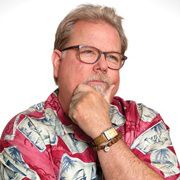
Bill Meagher is a contributing editor at NorthBay biz magazine. He is also a senior editor for The Deal, a Manhattan-based digital financial news outlet where he covers alternative investment, micro and smallcap equity finance, and the intersection of cannabis and institutional investment. He also does investigative reporting. He can be reached with news tips and legal threats at bmeagher@northbaybiz.com.
View all posts



